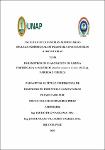| dc.contributor.advisor | Díaz Sangama, Emilio | |
| dc.contributor.advisor | Villacrés Vallejo, Jorge Ysaac | |
| dc.contributor.author | Ramirez Perez, Bruno Francisco | |
| dc.date.accessioned | 2022-03-28T18:30:19Z | |
| dc.date.available | 2022-03-28T18:30:19Z | |
| dc.date.issued | 2022 | |
| dc.identifier.uri | https://hdl.handle.net/20.500.12737/7914 | |
| dc.description.abstract | The present research was developed in part in the facilities of the Pilot Plant of preserves of the Faculty of Food Industries and the other part in the facilities of Empresa Natural Chacruna E.I.R.L. Being the raw material the cassava Manihot esculenta Crantz, pyric variety, which was acquired in the Caserío Ángel Cárdenas. First area, Carretera Iquitos-Nauta Km: 35.5, being its location Geodesic: 18M 0695814-Altitude 132 masl. Once the cassava arrived at the Plant, we proceeded to perform the analysis of the raw material following the methods of the A.O.A.C, of the year 2018, then it was processed following the steps: heavy, classified / selection, peeled, washed, fermented (48 hours immersed in drinking water, and then perform chemical physical analysis), crushed, rest (moment where it is fortified), then sifted (separation of the starch), the by-product of cassava rich in fibers, was subjected to a roasting in the facilities of the natural company Chacruna E.I.R.L, using a toaster, all of stainless steel which uses 4 gas balloons, to toast the product and obtain almi-free pharyndón, the two drying treatments that were 110 and 140 oC, for which in the first treatment, the roasting time was 6 hours and the second treatment was 4 hours, once the fariña yield was 13 percent, obtained, it was subjected to the chemical, microbiological physical analyses (determination of molds using the method of the I.C.M.S.F.), and acceptability analysis (20 untrained panelists were used, using a hedonic scale, evaluating: texture, color, smell, taste and general appearance), then with these results the statistical tests of acceptability of the two products (two treatments) were performed, using the statistical software SSPS, version 25, applying nonparametric tests , where they corroborate that the treatment (T2), is the one that obtained the best rating, being and concluding that it is the ideal treatment. | en_US |
| dc.description.abstract | La presente investigación se desarrolló en parte en las instalaciones de la Planta Piloto de conservas de la Facultad de Industrias Alimentarias y la otra parte en las instalaciones de Empresa Natural Chacruna E.I.R.L. Siendo la materia prima la yuca Manihot esculenta Crantz, variedad piririca, la cual fue adquirida en el Caserío Ángel Cárdenas. Primera zona, Carretera Iquitos-Nauta Km: 35.5, siendo su ubicación Geodésica: 18M 0695814-Altitud 132 msnm. Una vez que la yuca llego a la Planta, se procedió a realizar los análisis de la materia prima siguiendo los métodos de la A.O.A.C, del año 2018, seguidamente se procesó siguiendo los pasos: pesado, clasificado/selección, pelado, lavado, fermentado (48 horas sumergido en agua potable, y después realizar análisis físicos químicos), triturado, reposo (momento donde se fortifica), luego es cernido (separación del almidón), bagazo de yuca rica en fibras, fue sometido a un tostado en las instalaciones de la empresa natural Chacruna E.I.R.L, utilizando un tostador, todo de acero inoxidable el cual utiliza 4 balones de gas, para tostar el producto y obtener farina libre de almidón, los dos tratamientos de secado que fueron 110 y 140 oC, para lo cual en el primer tratamiento, el tiempo de tostado fue de 6 horas y el segundo tratamiento fue de 4 horas, una vez obtenido la fariña, asi mismo el rendimiento fue del 13% como fariña tostada, los sometido a los análisis físicos químicos, microbiológicos (determinación de mohos utilizando el método de la I.C.M.S.F.), y análisis de aceptabilidad (se utilizó 20 panelistas no entrenados, utilizando una escala hedónica, evaluando: textura, color, olor, sabor y apariencia general), seguidamente con esos resultados se realizaron las pruebas estadísticas de aceptabilidad de los dos productos (dos tratamientos), utilizando el software estadístico SSPS, versión 25, aplicando pruebas no paramétricas, donde corroboran que el tratamiento (T2), es la que mejor calificación obtuvo, siendo y concluyendo que es el tratamiento ideal. | es_PE |
| dc.format | application/pdf | es_PE |
| dc.language.iso | spa | es_PE |
| dc.publisher | Universidad Nacional de la Amazonía Peruana | es_PE |
| dc.rights | info:eu-repo/semantics/openAccess | * |
| dc.rights.uri | https://creativecommons.org/licenses/by/4.0/ | * |
| dc.subject | Elaboración de alimentos | es_PE |
| dc.subject | Fariña | es_PE |
| dc.subject | Yuca | es_PE |
| dc.subject | Manihot esculenta | es_PE |
| dc.subject | Alimentos fortificados | es_PE |
| dc.subject | Parámetros | es_PE |
| dc.title | Parámetros de elaboración de fariña fortificada a partir de Manihot esculenta Crantz, (yuca) variedad piririca | es_PE |
| dc.type | info:eu-repo/semantics/bachelorThesis | es_PE |
| thesis.degree.discipline | Ingeniería en Industrias Alimentarias | es_PE |
| thesis.degree.grantor | Universidad Nacional de la Amazonía Peruana. Facultad de Industrias Alimentarias | es_PE |
| thesis.degree.name | Ingeniero(a) en Industrias Alimentarias | es_PE |
| dc.subject.ocde | http://purl.org/pe-repo/ocde/ford#2.11.01 | es_PE |
| renati.author.dni | 70560896 | |
| renati.advisor.orcid | https://orcid.org/0000-0002-5424-0937 | |
| renati.advisor.orcid | https://orcid.org/0000-0001-7235-7971 | |
| renati.advisor.dni | 05222152 | |
| renati.advisor.dni | 08533246 | |
| renati.type | https://purl.org/pe-repo/renati/type#tesis | es_PE |
| renati.discipline | 721046 | es_PE |
| renati.level | https://purl.org/pe-repo/renati/level#tituloProfesional | es_PE |
| renati.juror | Cardeña Peña, Genaro Rafael | |
| renati.juror | Paredes Mori, Pedro Roberto | |
| renati.juror | Prado Mendoza, Wilder | |
| dc.publisher.country | PE | es_PE |


